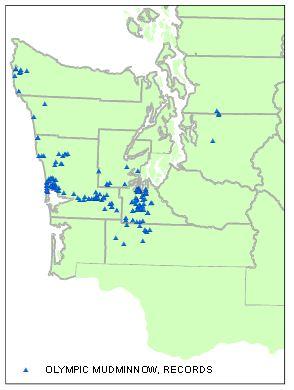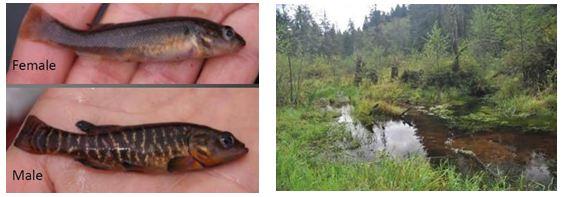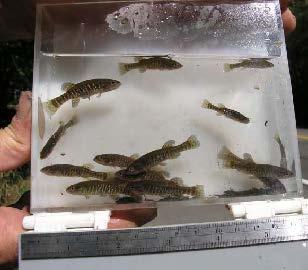Olympic Mudminnow (Novumbra hubbsi)
This article was originally published by the Washington Department of Fish and Wildlife as part of its annual report Threatened and Endangered Wildlife in Washington.

State Status: Sensitive, 1999
Federal Status: None
Recovery Plans: None
State Management Plan: None
The Olympic mudminnow (Figure 1) is a small (2–3 in; 50 –75 mm) freshwater fish found only in Washington. It is one of five species worldwide in the family Umbridae and is the only member of the genus Novumbra. Olympic mudminnows are found in the southern and coastal drainages of the Olympic Peninsula, the Chehalis river basin, south Puget Sound west of the Nisqually River (Mongillo and Hallock 1999), and a few sites in Snohomish and King counties (Figure 2; Trotter et al. 2000). They are usually found in slow-moving streams, wetlands, and ponds. Within these habitats, mudminnows require a muddy bottom, little or no water flow, and abundant aquatic vegetation.
There were likely many more Olympic mudminnow populations before Euro-American settlement of Washington when much more wetland habitat was available. Wetland loss in Washington since settlement is estimated to range from 20 to over 50 percent in various parts of the mudminnow’s range. Little is known about mortality and limiting factors, but mudminnows are less abundant when associated with exotic species of fish. Typically they do not occur where there are large, predatory fishes such as largemouth bass. This may be due to a combination of competition and predation. Mudminnows eat an assortment of invertebrates and have a high tolerance of low oxygen levels.
Most monitored populations of Olympic mudminnow seem to be stable. However, the species is completely dependent on healthy wetlands for its survival. Development which changes the hydrology (water diversions, increased storm flow, decreased summer-low flow, delivery of contaminants off impervious surfaces) and characteristics (substrate, vegetation) of a watershed can be detrimental to mudminnow habitat. Due to the mudminnow’s need for healthy wetland habitat and restricted range, it is vulnerable and requires habitat protection and cooperative management.
In 2010-2011, many historical sites were resurveyed; mudminnows were still present at most, but some habitat has been affected by land use practices (M. Hallock, pers. comm.). Electrofishing was used to catch and release fish in the 1973, 1993, and 2010-2011 surveys. Catch-per-unit-effort measurements were much lower at all sites in 2010-2011 than in 1973 and 1993. It is difficult to determine if this represents a real decline or is the result of habitat changes that made sampling more difficult in 2010- 2011. Development of a more efficient and accurate monitoring technique is needed. Many mudminnow habitats are mis-mapped or misclassified as “non-fish bearing” waters on the Washington State Department of Natural Resources regulatory water type maps, which can substantially reduce mudminnow habitat protection (Glasgow and Hallock 2009). The current mapping of mudminnow distribution among area streams, ditches, and wetlands does not adequately identify specific locations where fish are present or where presence should be presumed, and thus the regulations offer only limited protection for the species. Some important mudminnow habitat has been compromised because of a lack of fish distribution information and coordination among agencies.
During 2012, the U.S. Fish and Wildlife Service conducted additional surveys and collected fin clips for genetic testing to help determine the relative uniqueness of each Olympic mudminnow population. Nearly all of the sampling locations constitute separate populations with limited gene flow among populations. Populations from east of Puget Sound are most genetically similar to south Olympic populations and may represent introductions.
In October 2012, an Olympic Mudminnow Workshop was hosted by U. S. Fish and Wildlife Service (http://www.fws.gov/wafwo/Olymudminnow_wkshp.html). The goals of the workshop were to provide attendees with updated information on mudminnow biology and to establish a coalition of partners to develop and implement a conservation strategy for the species and its habitats.
Partners and cooperators: U.S. Fish and Wildlife Service, Wild Fish Conservancy.
Literature Cited
Glasgow, J. and M. Hallock. 2009. Olympic mudminnow (Novumbra hubbsi) in the Green Cove Creek Watershed, Thurston County, Washington: Distribution and Recommendations for Protection. Washington Department of Fish and Wildlife, Olympia. 18 pp.
Mongillo, P. E. and M. Hallock. 1999. Washington state status report for the Olympic mudminnow. Washington Department of Fish and Wildlife, Olympia, Washington. 36 pp.
Trotter, P. C., B. McMillan, and D. Kappes. 2000. Occurrence of Olympic mudminnow in the east side of the Puget Trough. Northwestern Naturalist 81:59-63.
Source: Washington Department of Fish and Wildlife. 2013. Threatened and Endangered Wildlife in Washington: 2012 Annual Report. Listing and Recovery Section, Wildlife Program, Washington Department of Fish and Wildlife, Olympia. 251 pp.







